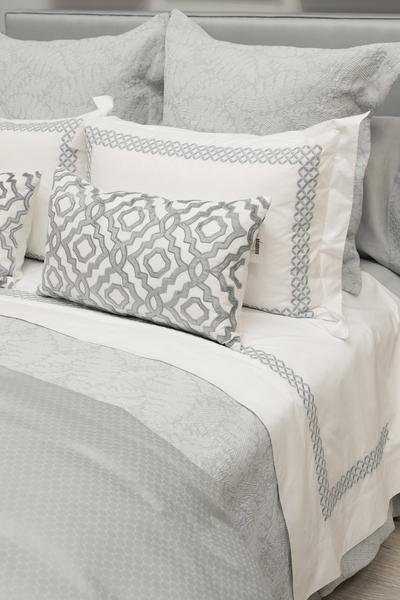Even for the most experienced of interior designers, mixing and matching patterns is one of the most difficult elements to master. When creating a bedroom you love, it can be tempting to order all of the coordinating pieces exactly as it's shown in a magazine or showroom, but seamlessly mixing colour, pattern, and texture is the key to creating a bedroom design that uniquely reflects you.
So now that you've decided that you'd like to do some creative mixing and matching, the question is... how? The process doesn't need to be a daunting one. We're sharing our four step process on how to mix and match like a pro in the bedroom.
Step One: Decide on your colour scheme
The first step to create an expertly curated bed is choosing a colour scheme. To start, we recommend choosing one piece that you LOVE and working from there. Whether it's patterned fabric for throw pillows, draperies, or even a rug, starting with one grounding piece and working from there is the best way to start your design journey.
If it's a patterned fabric, carefully analyze it and break down all of the colour elements in the fabric. Isolate every single colour used - this will be the colour palette you're working with. From there, choose 1 dominant colour and 1-2 secondary colours. Once you've isolated the colour scheme you'll be working with, it becomes much easier to mix and match.


Our Calais pattern is comprised of white, pale grey, pale blue, mineral blue, and charcoal. We pulled all of these colours to coordinate in a variety of textures and patterns.
Step Two: Cast a wide net
Once you've selected your colour scheme. It's time to go wild. Our favourite process is to pull EVERYTHING that interests you in your desired colour scheme - no holds barred. Gather fabric swatches, print pictures from the internet, and gather all of your colour elements together to create a mood board of sorts.


We loved this nautical-inspired Bologne collection and wanted to create a navy and white bed to complement it. We pulled a variety of blue and white fabrics from around the store, in a mix of patterns, textures, and colours.
Once you have everything in front of you, it's much easier to eliminate the pieces that you don't like as much and you can visually see which pieces work together and which ones don't.
Step Three: Mix it up
Now it's time to mix things up with scale, pattern, and texture. Of your favourite pieces, it's more visually appealing to incorporate a variety of shapes. For example, try mixing a geometric pattern with something more organic like a floral. If you've deciding on similar visual shapes (ex. a linear print like stripes or checks), try mixing scale. For example, pair a tiny check with a large Buffalo check.


If your bed is monochromatic, now is the time to go wild with texture. Try pairing as many textures as possible in the same colour: knit, matelasse, fur, smooth, velvet, etc.
Step Four: Break it up
Despite our credo that there's no such thing as too much mixing and matching, you never want your bed to feel garish and busy - it will exhaust you just by looking at it. We like to give patterns some visual breathing room by adding pops of solid colour between the patterns. Adding a plain sham on your mixed and matched bed will allow your eye to travel from pattern to pattern seamlessly.


The classic grey 2-line stitch on solid white cotton of our Loft 2-Line Grey pillowcases is the perfect solid to break up a variety of patterns.




